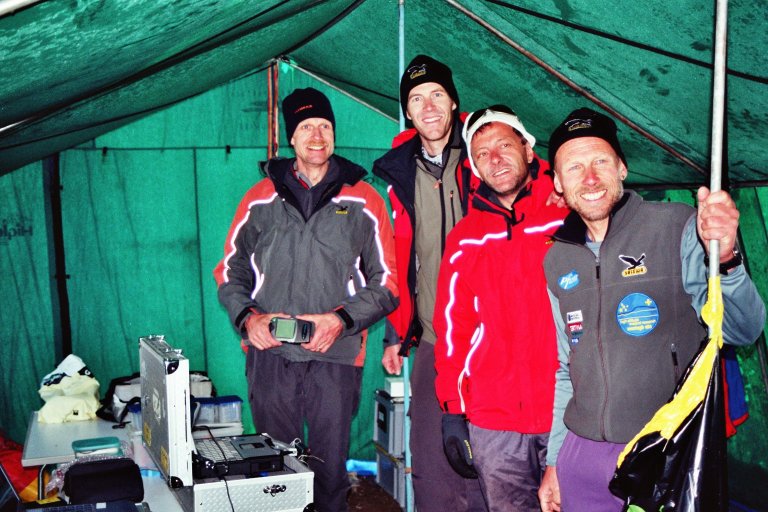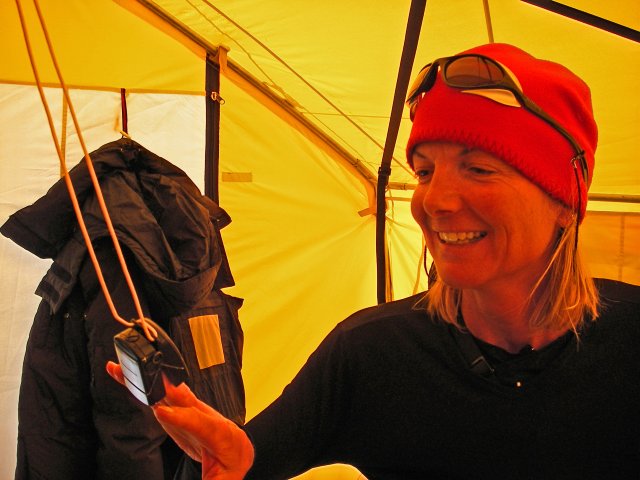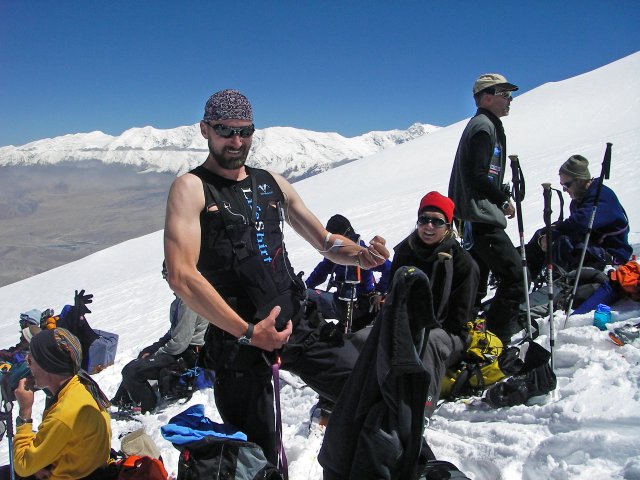To main page
The pulmonary team consisted of four physicians: Prof. Konrad
Bloch, Dr. Alexander Turk, Dr. Thomas Hess, and Dr. Otto Schoch.
Our aim was to investigate the mechanisms of cardio-pulmonary
acclimatization in healthy climbers during an ascent to Mutzagh
Ata (7546m) in Western China. In particular, physiologic adaptation
was compared among two groups ascending with different rates.
The results are expected to provide a scientific basis for
recommendations on altitude acclimatization, and prevention of
altitude related illness. In addition, the observations may help
to understand the physiologic mechanisms of physical impairment
in patients with various cardiac and pulmonary diseases.

|
| Pulmonary research team on Mutzagh Ata. Left to right:
Konrad Bloch, Alexander Turk, Otto Schoch, Thomas Hess.
|
|
Daily assessment comprised a questionnaire evaluation, a physical
examination focusing on signs of high altitude sickness, and measurement
of the arterial oxygen saturation by pulse
oximetry (Onyx® 9500, Nonin, USA).

|
| Participant Brigitte Kröni measuring the arterial oxygen
saturation with a finger probe.
|
|
By using a portable ultrasound transit time flow meter that
provides accurate estimates of airflow and dynamic lung volumes
even during extreme changes in ambient pressure and temperature
(EasyOne, ndd Medizintechnik AG, Zürich) we performed daily
spirometry in the base camp (4550m), camp one to three (5550m,
6250m and 6800m) and on the summit (7546m). Changes in spirometry
may give clues to identify exercise and cold air induced airflow
obstruction and subclinical fluid accumulation in the lungs
(high altitude pulmonary edema, HAPE).

|
| Participant Hans Spring performing a spirometry at 6200m.
|
|
Participants performed incremental bicycle exercise tests to
exhaustion before departure, and 2 to 3 times over the course of
the expedition. The results will demonstrate the effects of
altitude adaptation on maximal work capacity, oxygen consumption,
breathing pattern and heart rate. At camp 1 (5500m) the tests were
performed in a tent using high performance bicycle ergometers and
a metabolic unit (ZAN, Oberthulba, Germany).

|
| Participant Gabriel Schnetzler performing a cycle
cardiopulmonary exercise test in a tent at 5550m.
|
|
The goal was to examine breathing patterns during typical activities
of mountaineers during the ascent on skis, and over the nights while
sleeping in a tent at various altitudes. A special snugly fitting elastic
body garment (LifeShirt, VivoMetrics; Ventura, CA, USA) incorporating
sensors for monitoring of lung volume changes, along with the
electrical activity of the heart (ECG), and arterial oxygen saturation
by a finger probe was connected to a miniaturized data processing and
recording unit which was the size of a palm top computer (LifeShirt
Monitor). This device allowed breath by breath analysis of breathing
patterns and ventilation over the course of acclimatization. Analysis
of this physiologic data in correlation to symptoms and physical signs
will provide insight into determinants of mountain sickness in the two
groups ascending at different rates.

|
| Participant Stefan Wüthrich wearing the LifeShirt during
ascent to 6800m.
|
|




